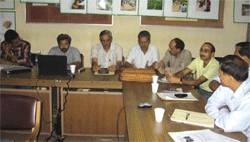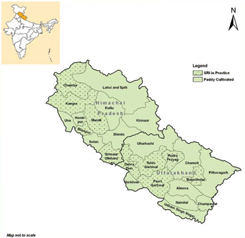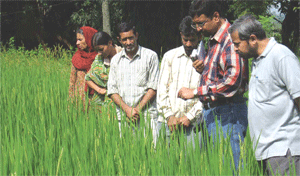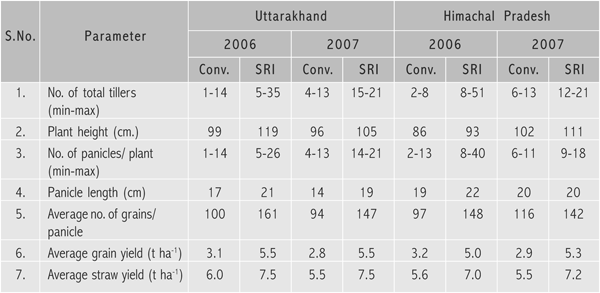|
|
 |
|
| SRI Fact Sheet - Uttarakhand & Himachal Pradesh |
|
 About PSI About PSI
People’s Science Institute (PSI) is a non-profit research and development organization based in Dehradun Its stated mission is, “To help eradicate pover ty through the empowerment of the poor and the productive, sustainable and equitable use of available human and natural resources.” Operationally, it provides technical and managerial support to communities and organizations that wor k with them; implements development programmes and undertakes public interest research. The Institute is known in India’s voluntary sector for its pioneering work in the fields of communityled watershed development, environmental quality monitoring and disastersafe housing. |
|
Background
The mountain states of Uttarakhand (UK) and Himachal Pradesh (HP) are characterized by inaccessibility, fragility, marginality, diver sity and human adaptation mechanisms. These features limit the scope for sustainable development based on intensive resourceuse. In the mountains villages, farm holdings are usually small, about 0.4 ha (1 acre) per family. As rice is the staple food in the mountain region, enhancing its productivity through the SRI method can lead to greater food security for farming families. The stalk volume in the SRI method is also much higher, providing more fodder for cattle, more farmyard manure for fertilizing fields and possibly increasing milk yields. Hence there is a need to promote the widespread use of the SRI technique in Himachal Pradesh and Uttarakhand. |
| |
| |
Himachal Pradesh |
Uttarakhand |
| Total paddy area (million ha) |
0.079(2006-07) |
0.28(2006-07) |
| ha) 0.079(2006-07) 0.28(2006-07) Major rice season(s) |
Kharif |
Kharif |
| Total paddy production (million tonnes) |
0.19(2006-07) |
0.83(2006-07) |
| State’s contribution to national paddy production (%) |
0.13 |
0.59 |
| Paddy productivity (t ha-1) |
2.33(2006-07) |
2.97(2006-07) |
| All-India rank in productivity2 |
24 |
15 |
|
 |
|
|
|
 In 2006, PSI heard about the potential of SRI and its experiences from the southern states and invited Mr. Kishan Rao, an experienced SRI practitioner from Andhra Pradesh to demonstrate the technique in few farms of UK and HP. WASSAN, Hyderabad extended required technical and financial support for the initial efforts. The SRI system was introduced in 40 paddy farms in 25 villages of UK (Dehradun, Rudraprayag and Tehri-Garhwal districts) and HP (Kangra district) to study its potential. Farmers were asked to plant paddy by the conventional and the SRI methods on adjacent fields. Under SRI, 12 to 15 days old seedlings were transplanted at 25 cm spacing, with recommended weeder-use after 10, 20 and 30 days of transplanting, and alternate wetting and drying of fields. The results showed an average increase of about 66 per cent in paddy yields from the SRI plots compared to the conventional plots. After seeing these results, other farmers in the selected and neighboring villages also expressed a desire to adopt SRI. Accordingly, in 2007, PSI organized 30 capacity-building workshops on SRI cultivation, (with the financial support of NABARD, Dehradun and SRTT, Mumbai) covering more than 1000 farmers. Finally about 600 farmers (in five districts of each of UK and HP) adopted SRI in 2007. Nine district-level experience sharing workshops were conducted in the month of October during harvesting of the paddy crop to share the results of SRI with farmers, scientists and policy makers to evolve a strategy for further promotion of SRI. Farmers who tried SRI expressed immense satisfaction with the results. In 2006, PSI heard about the potential of SRI and its experiences from the southern states and invited Mr. Kishan Rao, an experienced SRI practitioner from Andhra Pradesh to demonstrate the technique in few farms of UK and HP. WASSAN, Hyderabad extended required technical and financial support for the initial efforts. The SRI system was introduced in 40 paddy farms in 25 villages of UK (Dehradun, Rudraprayag and Tehri-Garhwal districts) and HP (Kangra district) to study its potential. Farmers were asked to plant paddy by the conventional and the SRI methods on adjacent fields. Under SRI, 12 to 15 days old seedlings were transplanted at 25 cm spacing, with recommended weeder-use after 10, 20 and 30 days of transplanting, and alternate wetting and drying of fields. The results showed an average increase of about 66 per cent in paddy yields from the SRI plots compared to the conventional plots. After seeing these results, other farmers in the selected and neighboring villages also expressed a desire to adopt SRI. Accordingly, in 2007, PSI organized 30 capacity-building workshops on SRI cultivation, (with the financial support of NABARD, Dehradun and SRTT, Mumbai) covering more than 1000 farmers. Finally about 600 farmers (in five districts of each of UK and HP) adopted SRI in 2007. Nine district-level experience sharing workshops were conducted in the month of October during harvesting of the paddy crop to share the results of SRI with farmers, scientists and policy makers to evolve a strategy for further promotion of SRI. Farmers who tried SRI expressed immense satisfaction with the results. |
| |
| The following steps were taken by PSI to promote SRI in UK and HP |
 |
Extend SRI experiment to at least 10,000 plots in UK with the financial assistance of Sir Dorabji Tata Trust (SDTT), Mumbai and Agriculture Directorate
|
|
|
 |
Extending SRI amongst 3,000 farmers of HP financial assistance from WWW-ICRISAT
|
|
|
 |
Selecting 30 Partner Organisations (POs) in UK and 10 POs in HP covering all the 13 districts of UK and five districts
of HP (Bilaspur, Chamba, Kangra, Mandi and Sirmour). |
|
|
 |
81 master trainers were selected and trained |
|
|
 |
The master trainers in turn conducted 334 two-day’ orientation workshops covering 15,110 farmers during March –
May 2008. |
|
|
 |
A user-friendly manual on SRI (in Hindi) was also prepared and distributed. |
|
|
 |
A set of marker and weeder was provided to a group of 10 farmers in each of the selected villages. The Agriculture Directorate, Dehradun came forward to subsidize 50 per cent of equipment cost and part of liquid manure required for
SRI in UK. |
|
|
 |
Field support was extended to the master trainers on a monthly basis throughout the cropping period. Agricultural
extension officers and trainers from local KVKs were invited to visit SRI fields during the cropping season. |
|
|
 |
Just before harvesting, exposure visits of farmers from adjoining villages of the same valley were organized |
|
|
 |
Coverage on SRI by information dissemination through the print and electronic media. |
|
|
 |
Advertisement spots on SRI were introduced on ETV channels. |
|
|
 |
Orientation workshops and exposure visits for Agricultural Officers of different districts of UK and HP were organized. |
|
|
 |
A Programme Advisory Committee (PAC) has been constituted in both the states consisting of a panel of experienced
scientists and government officials, who regularly appraise the SRI programme. |
|
|
 |
Eighteen one-day district-level experience-sharing workshops were organized in September-October 2008 at the time
when the paddy crop was being harvested |
|
|
|
Performance
The results in 2006 showed that in HP, the average productivity of paddy went up from 3. 2 t ha-1 to 5.0 t ha-1 about 56 per
cent. In UK, the average yield jumped about 77 per cent from 3.1 t ha-1 to 5.5 t ha-1. The results from 2007 showed that
while the non-SRI yields stood close to 2.8-2.9 t ha-1, the SRI yields were around 53-55 t ha-1, an average increase of 89 percent. Analysis of results of the trials in 2008 is underway by gathering yield data from the farmers and comparing the yields by the SRI and conventional methods. The data obtained in 2006 and 2007 are presented in Table 1. |
| |
| Table 1: Comparison between SRI & conventional paddy for Uttarakhand and Himachal Pradesh (2006 & 2007) |
| Grain yields obtained in farmers’ fields (2003-04) showed very few cases where SRI yields were lesser than conventional cultivation (Figure). |
 |
| An important factor contributing to the yields is related to the seed sowing time. The recommended seed sowing time for paddy under SRI for mountain regions is: (i) High Altitude (> 1500m) – 1-7 June, (ii) Medium Altitude (1000-1500m) – 10-20 June, and (iii) Low Altitude (<1000m) – 25 June – 5 July. Another crucial factor affecting the paddy yields is the transplanting age of the paddy seedlings. The grain yields reduce if the paddy seedlings are transplanted at a later stage. The average grain yields obtained under different transplanting time are (i) 10-15 days: 7.0-7.5 (t ha-1), (ii) 16-23 days: 5.5-6.0 (t ha-1), and (iii) > 23 days: 4.0-4.5 (t ha-1) During the field trials, it was observed that farmers who operated the weeder only once got less numbers of tillers while farmers who properly operated the weeder two or three times harvested a good yield. The average grain yields obtained under different uses of weeder are (i) Three Times : 7.0-7.5 (t ha-1), (ii) Two Times : 6.0-6.5 (t ha-1), and (iii) One Time : 5.0-5.5 (t ha-1). |
| |
| Table 2: Year-wise adoption of SRI in UK and HP |
 |
| Mountain farmers who took part in the field trials of paddy have expressed immense satisfaction with the results. They perceived the benefits in terms of (i) less seed requirement, (ii) saving in water, (iii), decreased workload on women, and (iv) high grain and straw yields. They also realized that SRI requires time-bound operations like sowing, transplanting, weeding,\ etc. for better results and is labour-intensive due to need of regular interculture operations. Another major feature of the SRI intervention has been the adoption of organic farming practices by the SRI farmers. Some of the constraints which need to be addressed while further promoting SRI in the mountain regions include (i) design modification of the Mandava weeder, especially for small terraces and different soil conditions, (ii) farmers’ accessibility to quality weeders and markers, (iii) capacity-building of farmers in the adoption of SRI technique, and (iv) availability of water under rainfed conditions, especially during transplanting and after the milking stage. |
| |
Way Forward
In December 2008, two state level workshops will be conducted in UK and HP where senior state-level officials and policy makers, farmers’ leaders and representatives of research institutions will participate. In the workshops, farmers’ experiences from the fields will be shared. The discussions will focus on future plans for extension of the techniques across the two states. PSI is already undertaking trials of crop intensification on other crops like wheat, finger millet (mandwa) and pulses (rajma). Efforts are on for constituting a federation of SRI farmers at the district as well as state level. The farmers, NGOs and district and state agriculture department officials should now put a resource-sharing mechanism in place that would address to the livelihoods needs and help achieve food security for the farmers of the two mountain states, especially the small and marginal farmers. Some other institutions which are undertaking trials on SRI on different crop varieties in their research farms for last one year or so include 1) Vivekanand Parvatiya Krishi Anushandhan Sansthan (VPKAS), Almora, 2) GB Pant University of Agriculture and Technology (GBPUAT), Pantnagar, and 3) Rice and Wheat Research Centre (RWRC), Malan, HP. |
| |
|
|
| |
|